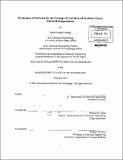Evaluation of sorbents for the cleanup of coal-derived synthesis gas at elevated temperatures
Author(s)
Couling, David Joseph
DownloadFull printable version (19.65Mb)
Other Contributors
Massachusetts Institute of Technology. Dept. of Chemical Engineering.
Advisor
William H. Green.
Terms of use
Metadata
Show full item recordAbstract
Integrated Gasification Combined Cycle (IGCC) with carbon dioxide capture is a promising technology to produce electricity from coal at a higher efficiency than with traditional subcritical pulverized coal (PC) power plants. As with any coal-based technology, however, it is of critical importance to develop efficient techniques to reduce the emissions of its many environmental pollutants, including not only carbon dioxide, but also sulfur and trace metals such as lead or mercury. One potential method to improve the efficiency for IGCC is through the use of solid sorbents that operate at elevated temperatures. Because many of these technologies are in their infancy and have yet to be commercially demonstrated, a strong desire exists to develop methods to critically evaluate these technologies more rapidly and inexpensively than can be done through experiments alone. In this thesis we applied computational techniques to investigate the feasibility of sorbents for the warm temperature removal of two key pollutants, carbon dioxide and mercury. We developed pressure swing adsorption models for the removal of carbon dioxide using both metal oxide and metal hydroxide sorbents and incorporated them into IGCC process simulations in Aspen Plus in order to evaluate the energy penalties associated with using these carbon dioxide capture technologies. We identified the optimal properties of CO2 sorbents for this application. Although warm CO2 capture using solid sorbents could lead to slight efficiency increases over conventional cold cleanup methods, the potential gains are much smaller than previously estimated. In addition, we used density functional theory to screen binary metal alloys, metal oxides, and metal sulfides as potential sorbents for mercury capture. We computed the thermochemistry of 40 different potential mercury sorbents to evaluate their affinity for mercury at the low concentrations and elevated temperatures found in the coal gas stream. We also evaluated the tendency of these sorbent materials to react with major components of the gas stream, such as hydrogen or steam. Finally, we tested the mercury adsorption characteristics of three of the most promising materials experimentally. Our experimental observations showed good qualitative agreement with our density functional theory calculations.
Description
Thesis (Ph. D.)--Massachusetts Institute of Technology, Dept. of Chemical Engineering, 2012. Cataloged from PDF version of thesis. Includes bibliographical references (p. 173-182).
Date issued
2012Department
Massachusetts Institute of Technology. Department of Chemical EngineeringPublisher
Massachusetts Institute of Technology
Keywords
Chemical Engineering.